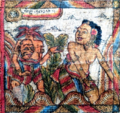Laweyan: Difference between revisions
(References) |
No edit summary |
||
| (2 intermediate revisions by the same user not shown) | |||
| Line 16: | Line 16: | ||
== Mythology / Religion == |
== Mythology / Religion == |
||
=== Image Variants === |
|||
<gallery> |
|||
File:Kawanda.png|Lintang Kawanda (CC-BY Alfred Maaß, (1929), Astrologische Kalender der Balinesen) |
|||
File:Lintang Goang.png|Lintang Goang in the cloth (CC-BY UPTD Museum Bali) |
|||
File:Lintang Gowang.jpg|Lintang Gowang (CC-BY Youla Azkarrula taken in the ceiling of Taman Gili Klungkung Palace Bali) |
|||
</gallery> |
|||
== Cultural Beliefs == |
== Cultural Beliefs == |
||
| Line 31: | Line 38: | ||
* {{NAMESPACE}} |
* {{NAMESPACE}} |
||
== All HIP Stars within this constellation == |
|||
Balinese take the lunar ascending node as their lintang, which also in the same case for Rahu in Vedic Jyotish. |
|||
== References == |
== References == |
||
| Line 37: | Line 47: | ||
[[Category: |
[[Category:Indonesia]] [[Category:Asterism]] [[Category:Constellation]] |
||
[[Category:Balinese]] [[Category:4workYoula]] |
[[Category:Balinese]] [[Category:4workYoula]] |
||
Latest revision as of 04:09, 21 November 2025
Laweyan is an Oceanic name from Bali (Indonesia). The lintang of laweyan is found in intersection of Rědite (Sunday, in saptawara) and Kliwon (in pancawara) in a series of palelintangan. Lintang laweyan means a headless demon constellation.[1]
Etymology and History
Laweyan
Spelling Variants
- lawean
- kawanda
- gowang
- gumawang
Origin of Constellation
Transfer and Transformation of the Constellation
Mythology / Religion
Image Variants
Cultural Beliefs
Numerology (Neptu/Urip)
Rědite (Sunday, in saptawara) has a value of 5 and Kliwon (in pancawara) has a value of 8. Thus, the total urip on this lintang is 13.[2]
Astrological Characteristics
Generally, they are patient, polite, good at debating, but they unknowingly like torturing themselves, do not want to listen to advice, gamblers, and are mischievous. Avoid jobs that are of bad quality, because there is danger lurking. If born a good woman takes care of the child, because there is a tendency for her child to die.[2]
Matching Gemstones
Kecubung (amethyst), Cempaka (yeloow saphire ), Ijo Rangreng (peros).[2]
Weblinks
All HIP Stars within this constellation
Balinese take the lunar ascending node as their lintang, which also in the same case for Rahu in Vedic Jyotish.
References
- References (general)
- ↑ Maass, Alfred, “Astrologische Kalender der Balinesen,” in Koninklijk Bataviaasch Genootschap van Kunsten en Wetenschappen, Feestbundel bij gelegenheid van zijn 150 jarig bestaan 1778-1928, 2 vols. (Weltevreden, 1929), Vol. 2, 126-157.
- ↑ 2.0 2.1 2.2 Tim Kajian Palelintangan, “Gabungan Kajian Palelintangan,” Museum Bali (2021), 1-149.







